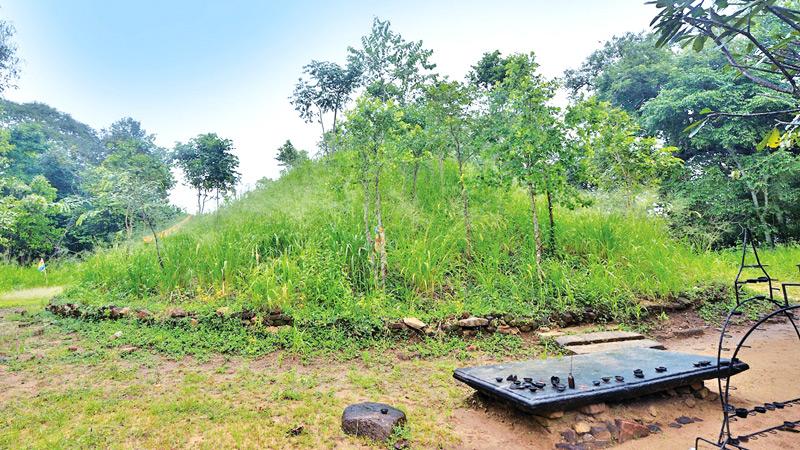
Looking for something different, something more adventurous, something off the beaten track, we decided to explore a lesser known and less travelled archaeological site, buried in the jungle boundaries of the Ampara and Moneragala Districts close to the Yala East National Park in Ruhuna.
 The journey is tough, uncomfortable and even dangerous. Our mode of transport is a four-wheeler, and we traverse muddy tracks, cross many streams and drive through jungles home to wild elephants, bears and even a leopard or two.
The journey is tough, uncomfortable and even dangerous. Our mode of transport is a four-wheeler, and we traverse muddy tracks, cross many streams and drive through jungles home to wild elephants, bears and even a leopard or two.
 A vast geographical area, Ruhuna in the times of kings, occupied a major part of the East, the whole of the South-East and the Southern and South-Western parts of the island, including what are now Batticaloa, Ampara, Moneragala, Hambantota, Matara and Galle. Although historical notes depict Anuradhapura as the most important kingdom in the country, possibly, in pre-colonial era, Ruhuna was a much larger, powerful region.
A vast geographical area, Ruhuna in the times of kings, occupied a major part of the East, the whole of the South-East and the Southern and South-Western parts of the island, including what are now Batticaloa, Ampara, Moneragala, Hambantota, Matara and Galle. Although historical notes depict Anuradhapura as the most important kingdom in the country, possibly, in pre-colonial era, Ruhuna was a much larger, powerful region.
Monuments
Even today, Ruhuna has many monuments visible only in fragments - Dagabas on hilltops, ancient walls crumbling in jungles.
The Wattarama Buddhist hermitage in the village of Kotiyagala that lies between Moneragala and Siyabalanduwa, is one such fascinating archaeological site.
The history of the Wattarama hermitage goes back to the reign of King Kawantissa, who ruled the Magama Kingdom. Today, ruins of the monastery, which flourished in the 1st and 2nd Century are scattered on the hillock. There are around six caves with drip ledges indicating these caves had been used by the monastic bhikkhus in the past. It is said that the Wattarama hermitage is one of the dwelling places of Arahat Maliyadeva, who had lived and preached in 60 places around the country.
From the top of the hill, one gets a magnificent view of the surrounding landscape dotted with many Dagabas. It is this collection of Dagabas that gives Wattarama its name.
The Wattarama hermitage consists of two sections, the upper and the lower. On entering the lower platform, which lies on the slop of the hill, one can see the ruins of several crumbling Dagabas, a shrine room and a Bodhigara. Here, you can also see the ruins of the main Dagaba, which is today just a mound of earth overgrown with creepers. Stone pillars indicate that there had been several structures with ancient brick tiled roofs.
Upper platform
The silent Wattarama hill is believed to be the upper platform of the hermitage, dotted with the caves where meditative bhikkhus were said to have dwelled.
The caves are still visible as one walks up the path leading to the upper platform of the hermitage. It is said that the meditative bhikkhus never descended to lower platform, as they had everything needed including a shrine room and placid pond, in the upper platform. Today, treasure hunters have caused extensive damage to the Dagaba and the ancient Buddha statue. What is left are stone pillars and broken bits of the statue.

Chief Incumbent Ven. Galgediyawe Piyasumana Thera, who arrived at the hermitage 26 years ago, revived the place from an abandoned shrine to the hermitage it is today. Over the years, he has added a new Dana Shalawa (alms hall), new Bodhigara (Bo tree enclosure) and shrine room. The hermitage currently accommodates several meditative bhikkhus from the different part of the country.
Terracotta images
The lower platform of Wattarama is littered with the surviving examples of terracotta images that originate from Ruhuna. These are sophisticated and elaborate, made from long flat clay bricks, and depict swans and elephant heads. Each terracotta image is a visual treat. Many archaeological remains lie half buried in the shrub jungle. The smaller pieces of terracotta found at various places were once kept in the hermitage ground, but are now displaced due to a lack of proper maintainance.
Piyasumana Thera said that the Wattarama hermitage has become a popular pilgrimage site these days, courtesy the 30-kilometre Kotiyagala route to Kebilitta Devale, which cuts across Wattarama, making the hermitage a transit point for weary devotees to rest and take in a little bit of ancient architecture before continuing with their journey.
